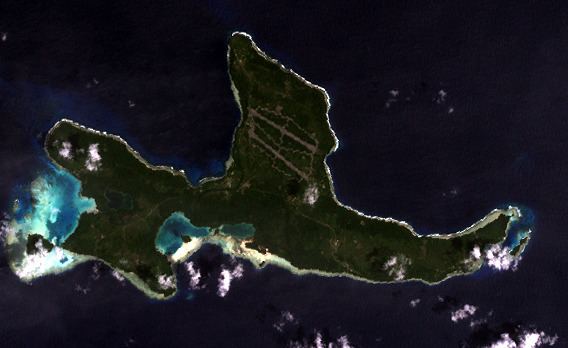 | ||
Emirau Island, also called Emira, is an island in the Bismarck Archipelago located at 1°38.5′S 149°58.5′E. It is currently part of the New Ireland Province of Papua New Guinea. The local language is a dialect of the Mussau-Emira language. Early explorers named it Squally Island, a name still found in some early records.
Contents
- Map of Emirau Island Papua New Guinea
- World War II
- Base development
- Garrison
- Motor Torpedo Boat operations
- References
Map of Emirau Island, Papua New Guinea
World War II
Early in World War II this tiny island became international news when over 500 prisoners from various ships (including RMS Rangitane) sunk by German surface raiders were released following the first attack on Nauru and subsequently rescued by the Australian authorities.
Emirau was seized unopposed by two battalions of the 4th Marine Division on 20 March 1944.
Base development
Construction activities were taken in hand by the US Navy Seabees of the 18th Construction Regiment, which consisted of the 27th, 61st and 63rd Construction Battalions and the 17th Special Battalion, which arrived between 25 and 30 March, and the 77th Construction Battalion which arrived on 14 April. The 27th built a PT boat base, an LCT floating drydock and slipway, and roads. The 61st constructed housing, ammunition storage facilities, a runway, and some of the buildings at the PT boat base. It also handled sawmill operations. The 63rd assisted at the sawmill and worked on the roads, camps, harbor facilities, warehouses, magazines and avgas dumps. The 77th built taxiways, hardstands, aviation workshops and the avgas tank farm. The 88th worked on runways, roads, radar stations and a causeway at the eastern end of the island.
Two airfields were constructed, Inshore and North Cape. These were heavy bomber strips, 7,000 feet (2,100 m) long and 300 feet (91 m) wide. The former had parking for 210 fighters or light bombers; the latter for 84 heavy bombers. Both were fully equipped with towers, lighting, and a dispensary. The aviation tank farm consisted of three 1,000 barrels (~140 t) tanks and nineteen 1,000 barrels (~140 t) together with the appropriate filling and distribution points. A reserve of 40,000 barrels (~5,500 t) was stored in drums. Three hospitals were established, a 100-bed naval base hospital, the 160-bed 24th Army Field Hospital, and the 150-bed Acorn 7 Hospital. The anchorage at Hamburg Bay could accommodate up to five capital ships. Port facilities included eight cranes, 42,000 cubic feet (1,200 m3) of refrigerated space, and 400,000 square feet (37,000 m2) of covered storage. The port could handle 800 measurement tons (910 m3) of cargo per day. Connecting the various facilities was 40 miles (64 km) of coral-surfaced all-weather road. All this work was completed by August and Construction Battalion Maintenance Unit (CBMU) 502 assumed responsibility for maintenance work. All the construction battalions departed by December.
Garrison
The 4th Marines were relieved as the garrison of Emirau by the 147th Infantry on 11 April 1944. The next day, General Noble was replaced as island commander by a marine aviator, Major General James T. Moore, the Commanding General of the 1st Marine Aircraft Wing. In turn, the 147th Infantry was relieved as garrison by the 369th Infantry in June. In August, General MacArthur directed that responsibility for garrisoning Emirau would be transferred to the Australian Army. The Australian 8th Infantry Battalion arrived to take over the garrison role on Emirau on 30 September. They were met by a small ANGAU detachment that had been on the island since May. Marine Aircraft Group 12 operated from Emirau until December, when it moved to Leyte, its place was taken by squadrons of the RNZAF.
On 20 March 1945, General MacArthur authorized a reduction in the garrison size to one company of the 8th Infantry Battalion. In June 1945, it too was withdrawn. CBMU 502 departed for Manus that month. The RNZAF maintained a bomber-reconnaissance squadron at Emirau until July 1945, and a fighter squadron until August, when all forces were withdrawn from the island.
Motor Torpedo Boat operations
USN Patrol Torpedo Boats (PTs) were based on Emirau Island. Squadron 11-2 (including PTs 177, 182, 185, and 186) under the command of LT John H. Stillman was transferred to Emirau Island in May 1944.
